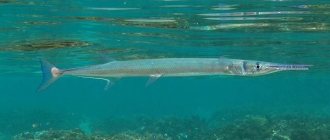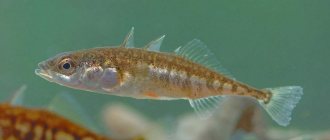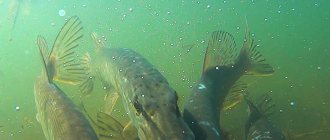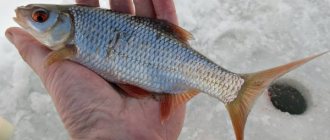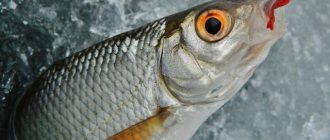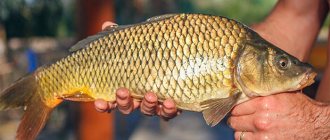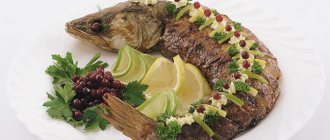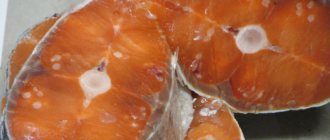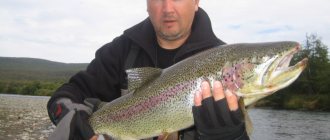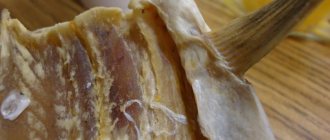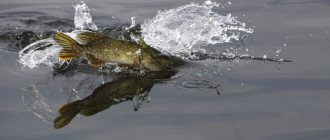- Wild animals
- >>
- Fish
The sharp-toothed predator pike has been familiar to almost everyone since childhood; one only has to remember the fairy tale about Emelya. Many would like to catch such a magical specimen that makes wishes come true. In our country, this fish is not at all uncommon; it prefers freshwater bodies of water. But besides the common pike, there are other species. Let's learn everything about this predatory fish in more detail by analyzing its habits, life rhythm and other important features.
Origin of the species and description
Photo: Pike
Pike is a predator fish belonging to the pike family, the class of ray-finned fish and the order Pike-shaped. To move on to the description of this fish, it is necessary to characterize its varieties, because they differ from each other not only in their places of distribution, but also in their external features. The pike genus has seven varieties of this fish. Two species of pike live on the territory of our country - common and Amur, and the remaining five are registered on the North American continent.
The common pike is the most numerous and has settled in both North America and Eurasia. We will look at this variety in more detail later; using its example, we will consider the external features of the fish.
Redfin pike (American) has a permanent residence in the east of the North American continent and is classified into two subspecies: northern redfin pike and grass (southern) pike. The length of these subspecies can reach up to 45 cm, and the weight is about a kilogram. A distinctive feature of these pikes is their shorter head. The grass pike does not have an orange color on its fins.
Video: Pike
Musking pike are very rare. She is the largest in her family. Its name means “ugly pike” in the Indian language. It is also called giant, because mature specimens can be more than one and a half meters long and weigh about 32 kg. The color can be silver, greenish, brown, and the fish is striped or spotted on the sides.
The striped (black) pike is very similar in appearance to the common pike, its body length can reach up to 60 cm, and its weight is about 2 kg, although there were also specimens weighing more than four kilograms. On the sides of this pike there is a pattern similar to a mosaic, and an almost black stripe runs over the eyes of the fish.
The Amur pike is smaller in size than the common pike; the largest specimens can reach a length of slightly more than a meter and weigh about 20 kg. The scales of the fish are small and have a silvery or greenish-golden color; brownish spots are located throughout the body of the pike, which makes its color similar to the color of taimen.
There are also pike hybrids bred by humans. Such individuals are not adapted to reproduction in the wild, and therefore are not an independent population.
Appearance and features
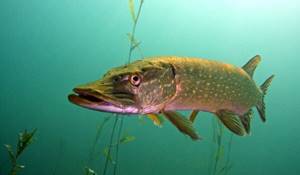
Photo: Pike fish
We will describe the appearance of the pike and all its characteristic features using the example of the common pike, the weight of which varies from 25 to 35 kg, and the length of the body reaches one and a half meters. The pike has a torpedo-shaped figure, the head of the fish is of considerable size, it is slightly elongated, because has elongated jaws. The upper jaw is flattened to the lower jaw, which, in turn, protrudes forward. This is the distinctive feature of the toothy predator. The teeth on the lower jaw have different dimensions, which makes it easier to capture the victim.
From above, the teeth are much smaller and point directly into the throat of the fish. Because of this feature, the caught victim is easily swallowed, but it is almost impossible for it to escape. Changing teeth is very typical for pikes, but the teeth do not change all at once, this process occurs in stages. The predator's eyes are rather large and set quite high, this helps her gaze at a large area without turning around.
If we talk about the colors of pike, they come in different colors. It depends on the body of water where the fish has settled, on the vegetation that predominates there and on the age of the predator itself.
The main tone of the fish can be:
- grayish green;
- yellowish-gray;
- grayish-brown;
- silvery (found in lake fish).
On the back, the pike always has a darker color, and on the sides of the fish there are brownish or greenish spots or stripes located across. The paired fins of the pike are orange, while the unpaired fins can be brown or gray with a yellowish tint. All fins have a rounded, streamlined shape, including the tail.
It has been noticed that female pike individuals are larger in size than male ones, their physique is not so elongated and their life expectancy is longer.
The urogenital openings are different in males and females. In males it is narrow, slit-like, has the color of the womb, and in females it looks like an oval depression, around which a pinkish ridge is visible.
An unusual classification of pike regarding its size exists among fishermen.
They highlight:
- grass, which lives in small rivers and lakes, its length in rare cases reaches half a meter, and its weight does not exceed two kilograms;
- deep-sea pike, which is found in deep-water rivers and large lakes, where the depth can be more than five meters. Such individuals grow up to one and a half meters in length and weigh about 35 kg, but are more often caught weighing from two to five kilograms.
This division of fish is arbitrary and not scientifically supported in any way. Most likely, the young live in shallow water so as not to become dinner for their large relatives, and there is more food near the shore. Adult pikes go deeper, choosing pools and underwater holes.
Body Shape
Pike has a long, streamlined and elongated body; it looks like a torpedo; thanks to this shape, the fish is capable of developing enormous speed in a matter of seconds. The head is greatly elongated, pointed at the end, the lower jaw protrudes forward. The fins on the body are located along the spine closer to the tail also to increase the speed of the fish. All fins are well developed and have a rounded shape. The predator has distinctive features, so it cannot be confused with other fish.
The body of the predator is covered with small, tightly fitting scales, which protect it from the sharp teeth of relatives and other predators. This is one of the largest fish in our latitudes, it can reach 2 meters; only catfish are larger than it.
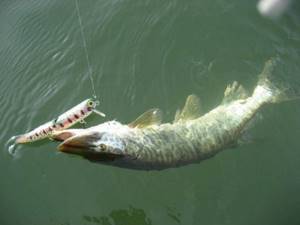
Coloring
The color of the pike fish is camouflage; on the body, everywhere except the belly, there is a camouflage pattern in the form of spots. This pattern of scales allows the fish to remain unnoticed in its habitat; it hides especially well in places with abundant vegetation and among snags.
The color of the fish depends on many factors: the age of the fish, food, landscape, etc. - so it’s difficult to say exactly what color the pike is. Young pike have a lighter color; the older the individual, the darker the body color. In closed ponds with vegetation and a high content of silt, the color is darker than that of individuals of the same age living in flowing reservoirs.
Most of the fish of this species are gray-green in color with spots or stripes of olive color. The back is darker than the belly, the belly is yellowish or grayish in color, with small specks of gray. The fins have a gray tint with pronounced stripes of light colors. A species of red-finned pike lives in North America.
The appearance of the predator makes it invisible in its habitat.
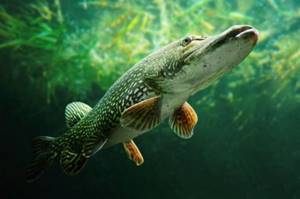
What class does it belong to?
The pike is a representative of the animal kingdom, the chordate type, the class of ray-finned fish, the pike family, the order Pike-shaped, the genus pike.
Representatives of the ray-finned class, which includes pike, are the most common species of modern fish. They differ from other classes in the structure of their fins. All representatives of the pike order are freshwater predators.
Mouth, vision, sense organs
The shape of the head is flattened and wedge-shaped, it is no coincidence that it gives the fish an additional area for viewing and allows you to accurately determine the speed of movement and the distance to all surrounding objects. The eyes are set high, which allows you to see everything above you, on the sides and slightly below. The lower viewing angle is blocked by the wide jaw of the fish, so if the prey is close, but at a lower level, the predator will not see it.
"Advice. If you want to catch pike with bait, do not cast your fishing rods close to the bottom. "
Pike in water also hears very well, thanks to this sense it can easily find prey even in muddy water. Even if the predator completely loses its sight, it will be able to survive and feed itself.
The mouth of the pike fish is elongated, similar to the jaws of a crocodile. Due to the special structure of the gill membranes, it can open very wide and capture particularly large prey. The predator is the only one among freshwater fish that is capable of swallowing prey 2/3 the size of its length.
Teeth and their replacement
The predator has about 3 thousand large and sharp teeth in its mouth, and several thousand small ones that resemble a brush. On the sides of the jaw of the pike fish there are fangs, they are long and sharp, and white in color. Inside the base they are empty, firmly connected to the jaw by a hard bone mass of a different shade. The pike also has many very small teeth in its mouth; they form brushes. They are located along the palate and on the tongue; if you stroke these brushes with your hand towards the throat, the teeth will bend, and in the opposite direction they will begin to dig into the skin. This was done in order to prevent the caught prey from escaping.
The pike's teeth are not chewing teeth; their purpose is to hold the prey in the mouth and prevent it from escaping; the predator swallows its prey whole. With its sharp teeth, it can easily cut a tied fishing line or net.
Pike teeth also have an interesting feature - they change throughout their life. It is difficult to obtain reliable information for what reasons and when this happens, and it is also not known whether small teeth change, since this process is difficult to control. But ichthyologists have established how large teeth—canines—are renewed. First, the old tooth changes color, dies and falls off the connective tissue. A new one grows in its place or close to it. At first, only protruding parts of tissue hold it in the mouth, and when you press a finger on a “young” tooth, it easily changes its inclination; if you find such a “soft tooth”, this is a sign that it is a “young” tooth. Over time, tissue similar to cartilage forms around it, and later it becomes similar to bone tissue. It holds the teeth tightly in the jaw, and it is no longer possible to move it with a finger.
Most fishermen believe the information that the pike changes its teeth once and during the full moon, at which time it stops hunting and because of this fishing is impossible. But this is not so, ichthyologists have accurately determined that teeth are renewed all year round and they are replaced gradually. However, it has not yet been possible to establish the reason why teeth begin to change; this question remains open.
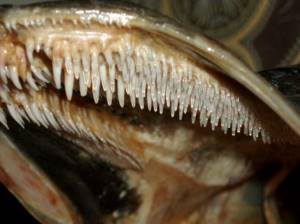
Internal structure
Like all bony fish, pike has a respiratory, circulatory, nervous and digestive system; pike has a well-developed spine and skeleton.
The respiratory system consists of gill slits - this is the respiratory organ. On the gill arches there are special plates with an abundance of capillaries, through which oxygen enters the fish’s body from the water. The circulatory system is closed and consists of the 1st circle of blood circulation. The nervous system includes the brain and spinal cord. There are also special nerve points on the fish’s body (not far from the eyes and along the lateral line of the body), with their help it can feel movements, even the most silent ones.
Like all fish, pike has a swim bladder, with its help it can swim freely at different depths. When environmental pressure changes, the fish fills the bladder with gases from the surrounding water and from its own body.
A feature of the internal structure of pike fish is the intestine, like that of all predators, it is short. Its ratio to body length is only 1:1.25 Because of this length, it has to eat often and hunt a lot; it is no coincidence that the fish is called voracious.
Where do pike live?

Photo: Pike animal
Pike is a typical inhabitant of freshwater bodies of water in Eurasia and North America. It can choose both coastal areas, which are overgrown with thick grass and reeds, as well as pools and holes located at great depths.
Grass (southern) pike live in the Mississippi River and other rivers flowing into the Atlantic Ocean. Black (striped) pike prefers to settle in lakes and overgrown rivers located from the south of Canada to the American state of Florida; its habitat reaches the Great Lakes and the Mississippi River. Amur pike lives in the reservoirs of Sakhalin Island, as well as in the Amur River. Italian pike has chosen the waters of northern and central Italy.
Pike also feels great in the waters of desalinated seas. For example, in the Finnish, Curonian, Riga bays of the Baltic, in the Taganrog Gulf of the Sea of Azov.
In our country, the common pike inhabits almost every second body of water. She lives in large and small rivers, reservoirs, ponds, and lakes. This toothy predator is unpretentious in choosing its permanent place of residence; here it can be compared with an ordinary crucian carp.
In lakes, young pike live close to the shore in grass, under snags, and sunken boats. Growing up to three to four kilograms, they move deeper into the lakes, finding their refuge in holes and pools. In rivers, both juveniles and adults live near the banks.
Many people mistakenly believe that pike can live for several centuries; this is not true at all. Usually pike live from 18 to 20 years, there are some specimens that live up to 30, but this is extremely rare. Often, when there is a lack of oxygen in the water, pike die, usually in winter in small enclosed reservoirs.
Pike Breeding - Part 1
Pike biology
Pike in Europe, Asia and North America is considered a valuable fast-growing fish. She prefers warm, slow-flowing or slow-flowing reservoirs. As well as bodies of water with brackish water.
Along with the common species in our country, there are three more species in North America, and in East Asia there is another species of pike, the commercial value of which is somewhat less; all representatives of the genus are very close relatives: their chromosome number is 2n=50. Most species can be successfully crossed with each other. The hybrid of two fast-growing species E. Masquinongy x E.lucius, which is also distinguished by its high vitality, deserves special attention.
Spawning usually occurs in the spring. Depending on the water temperature, reproduction lasts from February to June. The optimal temperature for reproduction in many reservoirs is considered to be 6-80C. Pike become sexually mature at the age of 2 years, and males can become sexually mature within a year. The pike spawns its reproductive products in floods, where the young find favorable conditions for feeding in the initial period of life. Juvenile pike lead a predatory lifestyle; within just a few weeks, they eat lower organisms and very quickly switch to feeding on fish. The mass of fish eaten by pike can average 10-20% of the mass of the pike itself. For 3 kg of forage fish, pike gives an average of 1 kg of weight gain. With a sufficient food supply, growth proceeds quickly. Males are generally smaller than females, which can reach weights of more than 25 kg.
In many countries, due to its lean meat, it is a favorite delicacy fish. Particular importance is attached to pike as an object of sport and recreational fishing. In some areas of Siberia, pike catches reach 20% of the total freshwater fish catch.
The decline in the pike population is caused by reasons such as intensive fishing, changes in water quality under the influence of technological progress, and the loss of natural spawning grounds. To maintain pike populations, on the one hand, work is underway to create natural spawning grounds, and on the other hand, great importance is attached to the cultivation of planting material for natural reservoirs.
Obtaining juveniles.
Pike spawners are caught from natural reservoirs shortly before or during spawning. Tops, as well as fixed nets and cast seines are used as fishing gear. But it is best to use electrofishing for these purposes. It is most advisable to catch pike at the stage of full sexual maturity. When she is looking for a spawning area, since in these cases no intermediate maintenance is required and the reproductive products can be obtained immediately after catching. In sexually mature individuals, reproductive products often leak out when fish are removed from fishing gear. If the fish have not yet reached sexual maturity, short-term aging is possible, but no more than 14 days. Producers are distinguished by gender shortly before and during spawning by the fullness of the abdomen (in females it is larger).
The optimal weight of breeding females is 1-3 kg, males - 0.5-1.5 kg. As the size of females increases, although absolute fecundity increases, relative fecundity tends to decrease. The number of eggs in fish of the same size can vary greatly (up to 50%). On average it is 15,000 - 45,000 pieces. per 1 kg of body weight. During spawning, female pike lose an average of 20-22% in weight. The eggs swell greatly in water, their average diameter is 2.4 - 3 mm. One liter of swollen caviar contains 44,000 – 60,000 eggs.
Special care is required when obtaining caviar. Even a small fall can damage the calf and lead to losses. When water is added, the eggs are no longer capable of fertilization after 1–2 minutes. Unfertilized eggs can be stored dry at low temperatures for 4–5 hours.
In general, male reproductive products account for only 1.5–2% of body weight. The milk is squeezed over the caviar. If reproductive products can be obtained from females that have not reached sexual maturity when caught after a short intermediate period, then in this case males must be given pituitary injections. For full use, sperm is collected using a pipette.
Artificial insemination is usually carried out using a semi-dry method. The eggs and sperm are carefully mixed and water is added. Since the caviar is still very sensitive at this moment, mixing the reproductive products should be done very carefully. The best fertilization results are obtained by adding a 1.5% solution of urea or table salt and urea.
The quality of the water is of great importance for fertilization, the pH value of which should be about 7. For more successful fertilization, it is advisable to keep the mixture of eggs and sperm for 1 - 2 hours before adding water. When receiving still unripe caviar, it can thus finally ripen. When transporting pike reproductive products, the mixture of caviar and sperm matures without adding water.
Since the eggs become very sticky within a maximum of 4–5 minutes after adding water, they are first washed generously to remove the stickiness. Due to the high sensitivity of pike eggs to mechanical stress, washing immediately after fertilization can lead to high waste and is therefore undesirable. Gluing of eggs can be avoided if the eggs after fertilization are placed in an incubator with light flow.
Weiss apparatuses are used to incubate eggs. The chemical composition of water, its temperature, oxygen regime and flow speed play a major role in this process. The optimal incubation temperature is 12 – 15 0C. Temperatures below 4 and above 210C have a detrimental effect on eggs. The supply water should be as saturated with oxygen as possible. The devices used are often imperfectly flow-through. In some places, zones with low oxygen content appear in them, which leads to increased waste. Oxygen consumption by embryos increases at least 20 times from the beginning of incubation to hatching. Considering the high sensitivity of pike eggs to mechanical stress, it is advisable to initially set a very weak water exchange and gradually increase it to 3 - 5 l/min. Lighting does not harm the eggs.
Approximately 2 liters of caviar are placed in a 7 liter apparatus, after swelling the volume increases to 6 liters. During incubation, dead white eggs are removed if possible, since at high temperatures their increased decomposition begins. At this time, fungicidal baths (malachite green, methylene blue and formaldehyde) can be used. When the stage of eye pigmentation occurs, live eggs can be separated from dead ones using baths of table salt, just like whitefish eggs. Incubation of pike eggs requires a total of 100 – 155 degree days.
Pike eggs can be left in the apparatus until hatching and the larvae can be transferred to fry trays for 1–2 hours before attachment. However, it is better to place the eggs in pools before hatching. You can use mesh fish hatching frames through which the young fish can fall through. Hatched embryos reach a length of 6–9 mm and a weight of about 10 mg. Incubation losses for pike are much higher than for other fish species, often ranging from 30 to 60%. At best they are 10 – 20%.
In the larval period of pike development, the stages of attachment and free swimming are distinguished. During the first time after hatching, pike larvae attach to the substrate using adhesive glands located on the head. This is facilitated by the use of coniferous tree branches or, best of all, a vertically suspended artificial fiber mesh. Active movement and feeding begins at a weight of 12 mg and a length of 12–15 mm. Only when the adhesive glands degenerate and the juveniles begin to float freely in the water can they be transported and planted in water bodies.
The number of pike fry is determined using a measuring cylinder with a mesh bottom, based on their calculation that 1 ml contains 50 - 60 pcs. When transporting larvae in plastic bags with oxygen, the stocking density can be 6000 - 7000 pcs./l.
The release of juvenile pike into lakes should be carried out in such a way that they do not accumulate in one place in the reservoir, but are distributed as widely as possible, for which it is necessary to select areas of reservoirs with good feeding conditions. The planting density is usually 1000 – 2000 pcs./ha. It is also recommended to raise young pike. This is especially important, since usually by the time the juvenile pike are released, there is a lack of food in the reservoir, which causes high losses of juveniles. Success is often determined by the type of fish and the method of landing.
What does pike eat?
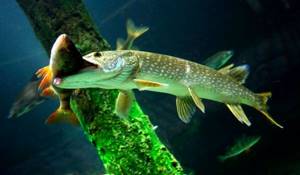
Photo: Pike in the water
The usual feeding hours for pike are early in the morning and evening; during the day, the predator is engaged in digestion, resting in a secluded place. Pike eats three times a year, then it feeds around the clock. The first zhor occurs before spawning (usually in March-April), the second occurs after spawning (in May-June), and the third occurs in August-September, sometimes in October.
The menu of this avid sharp-toothed predator includes a huge variety of fish; pike feeds on:
- roaches;
- perches;
- ruffs;
- breams;
- silver bream;
- bulls;
- minnows;
- loaches;
- pike.
It should not be surprising that this predatory fish happily eats its relatives. Cannibalism flourishes in the pike environment; a larger individual happily eats small pike, which is why these fish stay solitary and live apart from each other. In spring or at the very beginning of summer, pike can feast on both frogs and crayfish that are in the process of molting.
There have been cases when pike caught and pulled under the water small ducklings, rats, squirrels, mice, and waders swimming across the river.
Large pike individuals can attack ducks; this often happens when birds molt and cannot take off into the air. Also, large predators successfully catch fish whose size is half the size of the toothiest hunter or even a little more. Scientists studying the diet of pike have found that the menu of medium-sized pike consists mainly of fish, which are of no value and are numerous, so pike is very important for many fisheries, because it prevents the stocking of water bodies.
Pike breeding
Pike spawning begins in the spring when the ice melts. Females lay eggs on algae at a depth of 50 cm to 1 meter. And the males follow the females and fertilize them with their milk. One female can lay from 50 to 190,000 eggs! After 8 - 14 days, the fry hatch from the eggs. At first they feed on plankton, then they switch to fish larvae and soon begin a full-fledged hunt for small fish. Pike reach sexual maturity at 2-4 years of age. On average, pike live up to 20 years.
If you liked this material, share it with your friends on social networks. Thank you!
Features of character and lifestyle
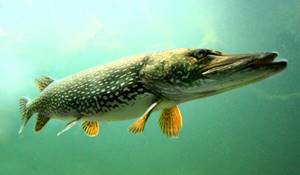
Photo: Pike fish
As already mentioned, pikes prefer living alone, this is no wonder, because they always run the risk of becoming victims of their larger relative. Only sometimes very small squirrels can hunt, forming small flocks. In any body of water, pike searches for dense aquatic thickets, where it freezes, waiting for its next victim. Seeing its snack, the pike makes a swift attack with one sharp jerk.
Medium-sized fish acquire their own territory, ranging from 20 to 30 square meters, and larger individuals have plots reaching up to 70 square meters. Several toothy predators can live in one area at once. They hunt in turns, while the sated one is busy digesting, the other one waits for prey. Not only their acute vision helps pikes make successful attacks, but also their lateral line, which improves orientation in space (seismosensory orientation).
The pike always swallows its prey, starting from the head, even if it was captured across the body.
When the weather is calm and sunny, even very large pikes appear in shallow water to sunbathe, so sometimes you can see whole clusters of such large fish basking. The saturation of water with oxygen is of the utmost importance for pike, because the fish is very sensitive to this indicator and can die if there is a lack of it, this often happens in small reservoirs during harsh winter periods.
In general, pike is a cold-loving predator. It has been established that the fish that lives in the northern regions grow over a longer period and live much longer than the pike living in the southern waters, this is how nature arranged it.
Social structure and reproduction
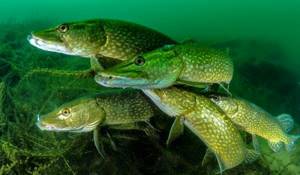
Photo: Pike
Female pike become sexually mature around four years of age, and males at five years of age. The suitable temperature for starting spawning is from 3 to 6 degrees plus. Spawning occurs immediately after the ice melts, near the shore, where the water depth does not exceed one meter. At this time, pike can be seen in shallow water, where violent splashes are heard. Usually the small specimens begin to spawn first, then the heavier fish join them.
Despite the fact that pike is a solitary fish by nature, during the mating season these fish form small schools consisting of several males (from 3 to 5 pieces) and one female. The female, as the leader, swims in front, and the males follow her, clinging to her side or being above her back. Spawning pike can rub against snags, roots, reed and cattail stems, which is how they spawn. When the spawning process comes to an end, strong splashes are common, and some pikes make high jumps.
The fry develop from one to two weeks, and the young fish's menu includes small crustaceans, and a little later - fry of other fish.
One pike can lay from 17 to 215,000 sticky eggs, the diameter of which is about 3 mm. Their number directly depends on the size of the female. First they cling to aquatic plants. After a few days, the eggs cease to be sticky and sink to the bottom, detaching from the plants, where they continue to develop. If after spawning the water begins to rapidly subside, then the eggs mostly die.
It happens that the eggs stick to the paws of the birds that eat them, so they are transferred to other bodies of water where pike have not previously been observed.
It is worth noting that in those reservoirs where the food situation is difficult, pike fry, reaching sizes of only half a centimeter, begin to eat each other at such a young age.
Where does pike live and its way of life
Pike lives in the northern hemisphere of our planet in most bodies of water. Found in salt and fresh water, they can live in both environments. There have been cases of pike being caught in the Baltic Sea several kilometers from the coast. Some fishermen caught pike in the Caspian Sea, which is also salty. In Astrakhan such pike is called Caspian, but in reality it is also an ordinary pike. Pike lives in reservoirs where the water temperature rarely exceeds 20 degrees.
Pike can be found in almost any body of water where there is a calm current or no current. Pike do not like strong currents; in it they cannot develop their maximum speed when throwing at prey, so they will remain hungry. They can often be found in overgrown lakes, hence the name grass pike. They use algae as cover to ambush prey.
Pike lead a sedentary lifestyle, they like to hide in stones or grass, they can conserve energy and remain motionless for a long time, so they wait for the moment to suddenly attack their prey.
Pike always chooses a place to live where there is a lot of water and food. They suffer from cannibalism, eating all their rivals in their habitat, so as not to be eaten themselves. There must be shelter in this place, so it is important that there is vegetation. For this reason, it is almost impossible to find pike in muddy water. There are always few plants in muddy water, so it is difficult for them to hide from their relatives, and it is almost impossible to organize an ambush.
We recommend: Where to look for pike on the river
In the waters of the northern hemisphere, pike is at the top of the food chain. She has no enemies except human life and larger relatives.
Pike are active only during the daytime; at night they are calm and rest most of the time.
This property is often used by fishermen who fish at night in a way that today is considered poaching, on a boat with a lantern and a strict line. At night, they can swim up to the pike in a boat and hit it with a strict attack; in most cases, it will stand still and not respond to the boat.
Natural enemies of pike
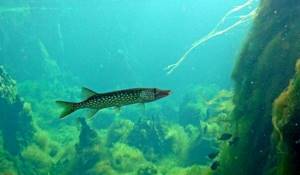
Photo: Animal pike
Despite the fact that the pike itself is very voracious, toothy and quite bloodthirsty, it has enemies who are not averse to feasting on it. Among the pike's detractors are otters and bald eagles, which love to eat all kinds of fish, including toothy pike. In Siberian rivers, pike compete with taimen, which copes excellently with predators of identical size, so in those places pike rarely reaches very large dimensions.
For pike living in southern waters, another enemy awaits them - large catfish. If large fish have enemies, then it is even more difficult for fry and young fish to survive; they often become prey for perches, rotans, and large pike perch. We should not forget that the pike itself eats its fellows, paying absolutely no attention to family ties.
In some northern lakes, pike cannibalism flourishes, where pikes feed only on their own kind. The food chain in those places looks like this: the fry eat small crustaceans, the fry are eaten by medium-sized relatives, and the latter become a snack for their heavier relatives.
Humans can also be considered the enemies of this toothy predator, because it is an honorable trophy for many fishermen who hunt for it. In some regions, pike fishing is not controlled in any way and is often massive. In addition, many fish die due to winter death, which usually occurs in small bodies of water.
Culinary value of pike
Pike fillet is rich in nutrients, minerals and vitamins. Eating it has a positive effect on the condition of the skin and mucous membranes, the health of the digestive and nervous systems. The meat of this fish normalizes blood sugar levels and acts as an antioxidant. It should be present in the diet if thyroid function is impaired.
Fish contains microelements that have a positive effect on metabolic processes in the body:
- magnesium;
- potassium;
- phosphorus.
Among other things, it contains B vitamins. Regular consumption of this fish (in any form) will reduce the likelihood of cardiac arrhythmia.
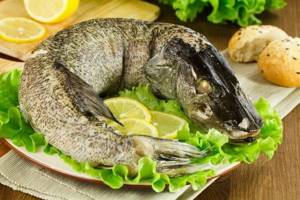
Pike fillet contains 84 kcal.
The nutritional value of the product is:
- proteins - 18.4 g;
- fats - 1.1 g;
- carbohydrates - 0 g.
